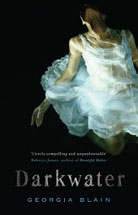Darkwater by Georgia Blain

Random House, 2010. ISBN 978 1864719833.
(Age 15+) Recommended. The waterfront suburb is like an island, water
on three sides, an enclave of well known streets, some shops, a school
and the riverside, where the kids hang out after school and on
weekends. Kids ride their bikes around the streets; they run messages,
do chores at home, drop in to see friends. Their lives are
uncomplicated. It is 1973; some smoke a little dope, others have close
boyfriends and girlfriends, they all go to school together and most
have known each other since kindergarten. But Amanda Clarke is dead:
murdered, her body found half floating in the water near where they all
meet. It splinters the group like nothing else. They become suspicious
and wary of each other; their once safe suburb now locks its doors,
with parents picking the children up after school, and warning them to
be on their guard.
Winter writes her dairy, revealing the facts and beliefs of her group,
speaking for the senior students at her school. She knew Amanda, but
only as a girl in a higher grade, part of the group which included her
brother, Joe. Through the diary the writer examines all the events
surrounding the murder and so details all the characters. They become
real people, grieving for their lost friend, but also harbouring
beliefs about who killed this popular girl.
The book is a fascinating look at the loss of innocence, the change of
a once trusting community to one where people look upon their
neighbours with suspicion. And Georgia Blain has drawn this community
with an elegant ease. No word is out of place, the whole is
meticulously researched, the times recreated with an eye for detail
which is stunning. From the intellectually disabled boy and his mother,
cocooned in their house by the sea, to the women striving for some
independence, the developer attempting to build on the last piece of
untouched waterfront land, the green bans and intimidation within the
building industry; all are part of a background which firmly places the
story in the 70's. The school too, the wallpaper of the lives of its
students, plays a part in the developing story which is redolent of the
intertwining lives of this group of teenagers.
I thoroughly enjoyed reading this story and recommend its inclusion in
secondary libraries and in a list of texts for year 9 and above.
Fran Knight